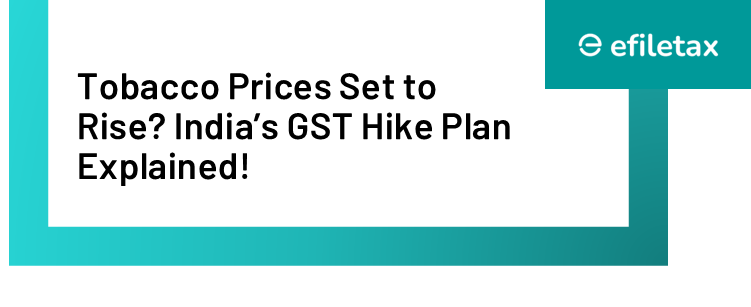
Introduction
India is considering a Goods and Services Tax (GST) hike on tobacco products once the compensation cess ends on March 31, 2026. Currently, tobacco products attract 28% GST, along with compensation cess and other levies, pushing the total tax burden to 53%. However, as per government discussions, one of the key proposals is to increase GST to 40% and introduce an additional excise duty.
This move is aimed at ensuring a stable revenue stream from tobacco products after the cessation of compensation cess. The final decision, however, rests with the GST Council.
Current Tax Structure on Tobacco Products
- GST: 28%
- Compensation Cess: Varies based on product type (e.g., ₹2,076 – ₹4,170 per thousand units for cigarettes)
- Other Levies: Basic excise duty and National Calamity Contingent Duty
- Total Indirect Tax Burden: 53% (below WHO’s recommended 75%)
Proposed Changes in Taxation
- Increasing GST from 28% to 40% (the highest permissible limit under GST laws).
- Supplementing GST with additional excise duty to compensate for revenue loss post-cess.
- Eliminating the compensation cess instead of replacing it with another levy.
- Alternative Proposal: Introduction of a ‘health cess’ in place of the compensation cess.
Why is the Government Considering a GST Hike on Tobacco?
1. Revenue Stability
Tobacco products contributed ₹72,788 crore in tax revenue in FY 2022-23. To maintain this revenue stream, officials are exploring higher GST rates or additional excise duty.
2. WHO Recommendations
The World Health Organization (WHO) recommends a 75% tax burden on tobacco to discourage consumption. India’s current 53% tax rate is significantly lower.
3. Public Health Goals
Higher taxation is known to reduce smoking rates and lower healthcare costs related to tobacco-related diseases.
Industry & State Government Reactions
- GST Council Deliberations: The ministerial panel is reviewing the tax structure and is expected to submit a report before 2026.
- State Concerns: Some state governments oppose a health cess, arguing it could affect business margins.
- Industry Opposition: Tobacco manufacturers argue that higher taxes could encourage illegal trade and smuggling.
Legal and Policy Considerations
- GST Council’s Fitment Committee has been asked to evaluate whether the cess should be merged into existing tax slabs or replaced with another levy.
- Supreme Court rulings on sin goods taxation may impact the final decision on restructuring GST rates.
- A previous GoM on tobacco taxation recommended linking cess to the maximum retail price (MRP) instead of sales value, but this is yet to be implemented.
Key Takeaways for Businesses and Consumers
- For Consumers: Expect higher prices for cigarettes, pan masala, and other tobacco products.
- For Businesses: Higher compliance costs may arise due to new taxation structures.
- For State Revenues: States may need to find alternative revenue sources if tobacco sales decline.
FAQs (Based on Google’s ‘People Also Ask’)
1. What is the current GST rate on cigarettes and tobacco in India?
Tobacco products attract 28% GST, plus a compensation cess and excise duties, totaling a 53% tax burden.
2. Will tobacco products become more expensive after 2026?
Yes, if the proposed GST hike to 40% is implemented, along with an additional excise duty or health cess, prices will increase.
3. Why is India considering a tax hike on tobacco?
The government aims to maintain tax revenue after the compensation cess ends and align with WHO’s 75% tax burden recommendation.
4. Will smuggling increase if GST is hiked?
Higher taxation on tobacco has historically led to an increase in illegal trade, but stronger enforcement can mitigate this risk.
5. When will the final decision on GST rates be announced?
The GST Council’s report is expected before 2026, after deliberations with states and industry stakeholders.
Conclusion
India is moving towards a higher tax regime on tobacco products, aligning with global health standards and revenue goals. While the GST Council is yet to finalize the decision, consumers and businesses should prepare for higher taxation on cigarettes and other tobacco products post-2026.